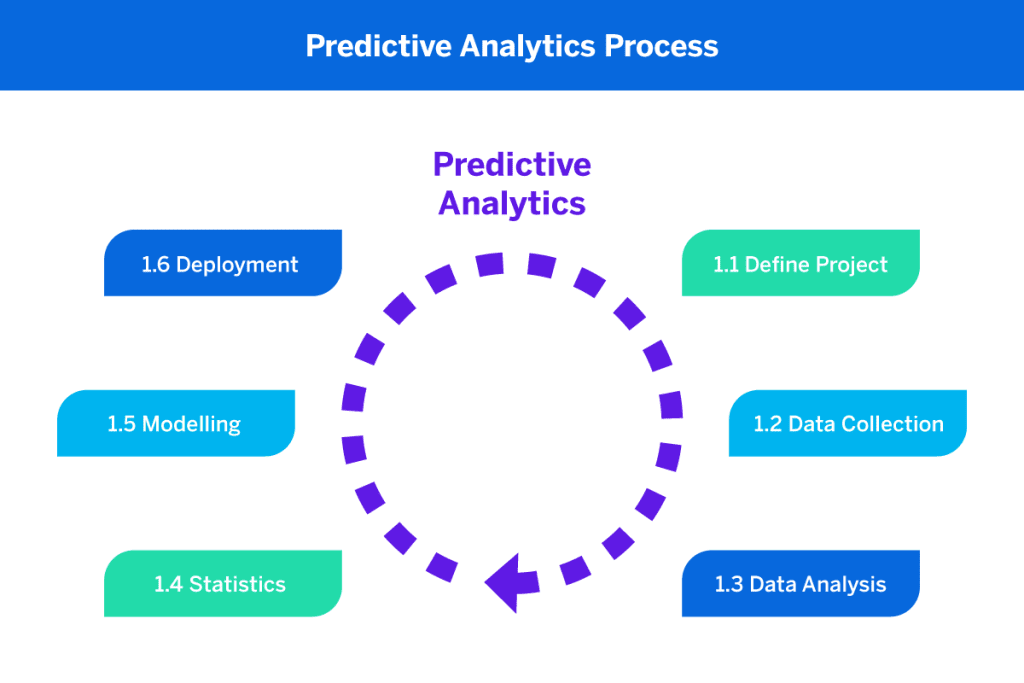In today’s ever-evolving marketing landscape, staying ahead isn’t just an option, it’s a necessity. That’s where predictive analytics comes in. It’s a powerful tool that’s revolutionized the way marketers compete.
In this article, we’ll dive deep into the details of predictive analytics — what it is, why it’s important, what it’s role in marketing, how it works, the benefits it provides, and the challenges that come with implementing it.
Contents
Defining Predictive Analytics
Predictive analytics is the strategic practice of utilizing historical and real-time data, coupled with statistical algorithms and machine learning techniques, to forecast future outcomes. This sophisticated approach empowers marketers to make proactive decisions by identifying patterns, trends, and correlations, ultimately providing a unique vantage point for strategic decision-making.
The image is from What is predictive analytics? Your ultimate guide.
Predictive analytics can be used in a variety of business environments, such as experience management programs to model the effect of potential future actions on an organisation.
The use of predictive analytics can revolutionise the way an organisation makes decisions, as it allows organisations to ‘guess’ the outcomes of potential future actions before deciding which course of action to pursue.
It is important to note, however, that predictive analytics is not infallible. The predictions will sometimes be wrong, but they are still a powerful way to avoid blind guesswork.
The Role of Predictive Analytics in Marketing
Predictive analytics isn’t just a buzzword; it’s a linchpin in modern marketing strategies. By scrutinizing customer data — encompassing demographics, purchasing history, online behavior, and social media interactions — marketers gain a profound understanding of their audience. This knowledge becomes the catalyst for personalized marketing campaigns, targeted offers, and the delivery of relevant content across various channels.
Benefits of Predictive Analytics in Marketing
- Enhancing Customer Experience: Predictive analytics empowers marketers to understand individual preferences, anticipating customer needs. This results in personalized product recommendations, customized offers, and tailored content, fostering stronger relationships, increased satisfaction, and repeat business.
- Optimizing Marketing Strategies: Marketers can optimize their strategies by identifying the most effective channels, messages, and timing for campaigns. This data-driven approach ensures efficient budget allocation, maximizing return on investment and boosting overall campaign effectiveness.
- Increasing Return on Investment: Leveraging predictive analytics allows marketers to make accurate predictions about customer behavior, enabling them to target high-value customers. Focusing efforts on these segments increases acquisition and retention rates, ultimately maximizing return on investment.
Challenges in Implementing Predictive Analytics
- Data Privacy and Security Concerns: Ensuring data privacy and security is paramount. Organizations must establish robust data governance practices, adhere to regulatory requirements, and implement strong security measures to protect customer information.
- Need for Skilled Professionals: The complexity of predictive analytics demands skilled professionals with expertise in interpreting complex algorithms, strong statistical and analytical skills, and the ability to derive meaningful insights from data. Investing in training programs and fostering a data-driven culture is essential.
- Integration with Existing Systems: Integrating predictive analytics into existing systems can be complex. Marketers must ensure compatibility, scalability, and seamless integration with current technology stacks, potentially requiring investments in new infrastructure and updates to legacy systems.
Conclusion
In conclusion, predictive analytics is a formidable force reshaping the marketing landscape. It propels data-driven decision-making, providing marketers with invaluable insights into customer behavior and optimizing strategies for measurable business results. While challenges exist, addressing data privacy concerns, investing in skilled professionals, and ensuring seamless integration will position organizations to harness the true power of predictive analytics for future marketing success.




